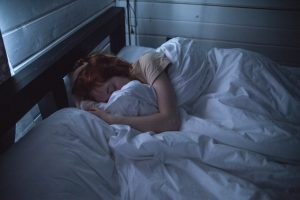The Sleep Cycle and Bedwetting

Our sleep is not just a one, long unit. During the night, we go through several rounds of sleep cycles. Each sleep cycle is comprised of four to five sleep stages: 3-4 non-REM sleep stages, and one REM sleep stage. Typically, we will go through four to six sleep cycles a night, which last – on average – around 90 minutes. When it comes to bedwetting, the sleep stage the child is on is also a factor that can help to determine whether the child can wake up and go to the toilet.
– Read more about the reasons for a child to wake up and go to the toilet
The sleep stages in the sleep cycle are:
STAGE 1 (N1)
⏰ Around 1 to 5 minutes
Where the body still needs to fully relax. Brain activities start to slow down, feeling of tiredness and falling asleep.
👀 Easy to wake up
STAGE 2 (N2)
⏰ Around 10 to 60 minutes
Where we can locate further relaxation in the muscles, a drop in body temperature, slower breathing and stopping of the eye movement.
👀👀 Harder to wake up
STAGES 3-4 (N3, N4 Delta Sleep, Seep Sleep, Slow-Wave Sleep)
⏰ Around 20 to 40 minutes
Where the body is in deep sleep. Breathing rate and pulse are lowered down, and muscles are loose.
Later on, the brain moves to function in long and slow waves.
👀👀👀 Very hard to wake up
REM STAGE (Rapid Eye Movement)
⏰ Around 10 to 60 minutes
Where the body experiences atonia (temporary paralysis of the muscles), except for the eyes and the breathing muscles. This stage is ‘famous’ by the look of the eyes moving around, even if they are closed.
👀👀👀 Very hard to wake up
>> Visit our FAQ section for more information about bedwetting treatment
>> To learn more about our plans and pricing click here
Search
Recent Posts
- Summer Sleepovers and Bedwetting: A Parent’s Guide to Confidence and Comfort
- Hot Weather and Bedwetting in Children: What You Should Know
- Springtime and Bedwetting in Children: What’s the Connection?
- Understanding Restraint Mechanisms and Bedwetting in Children
- Giggling and Bedwetting: Why Laughter Sometimes Leads to Leaks
Categories
- ADHD
- adult bedwetting
- All about Bedwetting
- bed wetting
- bed wetting alarms
- bed wetting treatment
- bedwetting
- bedwetting blog
- bedwetting causes
- Bedwetting Dictionary
- bedwetting medication
- bedwetting solution
- bedwetting solutions
- bedwetting therapee
- bedwetting therapy
- diurnal enuresis
- dribbling
- How to stop bed wetting
- nappies
- News
- primary enuresis
- progress chart
- secondary enuresis
- sleep
- sleepovers
- The Solution – Therapee
Tags
Archives
- June 2025
- May 2025
- March 2025
- November 2024
- October 2024
- September 2024
- August 2024
- May 2024
- April 2024
- March 2024
- February 2024
- January 2024
- December 2023
- September 2023
- August 2023
- July 2023
- June 2023
- May 2023
- April 2023
- March 2023
- February 2023
- January 2023
- December 2022
- November 2022
- October 2022
- September 2022
- August 2022
- July 2022
- June 2022
- May 2022
- April 2022
- March 2022
- February 2022
- January 2022
- December 2021
- November 2021
- October 2021
- September 2021
- August 2021
- July 2021
- February 2015
- January 2015
- December 2014
- November 2014
- October 2014
- September 2014
- August 2014
- July 2014
- June 2014
- May 2014
- April 2014
- March 2014







